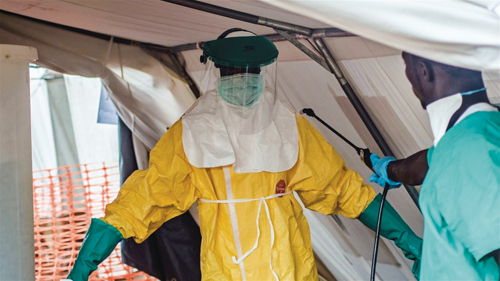The Healthy Dose – Ebola, Part 2
By Parth Dwivedi
Recapping last week’s installment, there are multiple species of Ebolavirus that are each slightly different and thus have different effects. Fruit bats are the natural carrier for the virus and it is dangerous to humans because its relative isolation prevented us from adapting to it. Infection occurs through bodily fluids.
Ebolavirus binds to proteins on the surface of its host cell, which triggers a signal in the cell telling it to allow viral contents in. In other words, the virus tricks the host cell into thinking it is not harmful. Once in, the viral RNA gets to work hijacking the cell to produce more viruses.
Ebola Virus Disease is a hemorrhagic fever, which means that it eventually causes hemorrhaging (bleeding) throughout the body. The bleeding itself is not fatal, although it certainly gives Ebola victims the characteristically gruesome appearance.
The first symptoms seen are usually fever, intense weakness, muscle pains, headache and sore throat. A host of other diseases meet these criteria, though, including malaria, typhoid fever, cholera, meningitis and hepatitis to name a small fraction.
Thus, it is very difficult even to diagnose Ebola until the disease progresses considerably. “When was the last time you wore gloves, eye protection, and [a mask] when your child had diarrhea?” wrote Dr. William Fischer II, who documented his experiences combatting Ebola in Guinea from May 2014 through June 2014.
Additionally, the uncertain diagnosis increases the spread of the disease, as isolating someone without knowing for certain that they have Ebola is highly questionable.
Eventually kidney and liver function decline and the characteristic rashes appear. Vomiting and diarrhea contribute to significant water loss, which largely contribute to death. Ebolavirus directly attacks the body’s immune system as well, which enhances its effects.
As the body continues to secrete fluids after death, Dr Fischer notes that Ebola makes participating in a funeral a danger to loved ones. He sadly writes, “This virus has transformed tradition into transmission.”
No reliable cure or vaccine for Ebola exists, although laboratories across the world are scrambling to produce something. Historially, about 90% of those infected die, but in the ongoing outbreak about 50% have died. Survival is possible and Dr. Fischer recommends aggressive fluid replacement and hydration as a treatment—not a cure.
Dr. Fischer’s journal is published at news.unchealthcare.org as, “Dispatch from Guinea: Containing Ebola.”
Join us next week when we discuss large-scale implications of the most recent Ebola outbreak.

Parth Dwivedi has a B.A. in Neuroscience and an M.S. in Biomedical Sciences. He likes reading non-fiction and still watches I Love Lucy.

